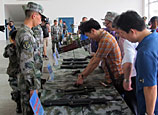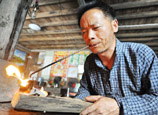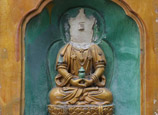
Emperor Qinshihuang’s Mausoleum
Emperor Qinshihuang’s Mausoleum, a world cultural heritage site, a key cultural relic under state protection and a national AAAAA-level scenic area, is located in the Lintong District, Xi’an. The mausoleum is one of the world’s largest, best designed and richest in funeral objects, and is the first mausoleum in Chinese history. It is also a very mysterious underground kingdom. The deep and quiet underground palace is full of mystery, as its shape and inner structure are still not completely known. For thousands of years it has aroused thoughts and reveries among generations.
Located to the east of Xi’an in Lintong District, Emperor Qinshihuang’s Terracotta Army Museum is a key cultural relic under state protection and has been recognized as the world cultural heritage site and a national AAAAA-class tourist attraction. The museum, built on the original site of the terracotta army pits, is so far the largest museum on the ancient military in the world. Since its opening, the museum has attracted millions of visitors each year and has been acclaimed as “the eighth wonder of the world.” Visitors are overwhelmed by the huge size of the pits, the spectacular scene of the battle formations, and the advanced scientific and artistic levels of the relics.
Han Yangling Museum
Han Yangling Museum is a key cultural heritage site under state protection and an AAAA national attraction. The tomb was for Emperor Liu Qi in the western Han dynasty and has a large number of sacrificial burial pits and satellite tombs. The exquisite cultural relics unearthed vividly reproduce the imperial cultural and social life in the Han dynasty. Now the museum is the first complete underground museum with the most advanced relic protection and exhibition technology in the world, allowing visitors to view the abundant relics at different angles within a short distance.
Ancient Han Platform
This ancient Han Platform was built during the Chu-Han warring time in the center of Hanzhong city with an area of 8,000 square meters. Together with Hanzhong Museum inside, the site is now an AAA national attraction and has been recognized as a cultural heritage site under provincial protection. The 7-meter platform is composed of three terraces. To its north end stands the Wangjiang Tower and to the south grow several old osmanthus trees. These osmanthus trees give off exquisite fragrance during the Mid-autumn Festival season and attract lots of visitors to watch them. The Shimen cliff inscriptions collected in the museum, also known as “thirteen treasures of the Han and Wei dynasties,” are spoken highly of by archeologists and calligraphers.
Maoling Mausoleum Maoling Museum
Maoling Mausoleum was built for Emperor Li Che in the Maoling Village Xinping County about 40 kilometers northwest of Xi’an in the Western Han Dynasty. According to historic records and the latest research, Maoling mausoleum was not only the largest imperial tomb that took the longest time to construct but also the tomb that contained the richest burial objects in the Western Han Dynasty. Maoling Museum which was constructed on the site of General Huo Qubing’s tomb has collected the earliest and most completely preserved stone carvings in China. These stone carvings are extremely valuable for the study of the Han Dynasty arts. The mausoleum and the museum are enlisted as key cultural heritage site under state protection and are honored as AAAA national tourist attractions.
Sima Qian Memorial Temple
Sima Qian Memorial Temple, situated on the southeastern hummock of Zhichuan town, 10 kilometers south of Hancheng City, is a key national cultural heritage under state protection and a an AAA national attraction. Sima Qian has been crowned with eternal glory for his masterpiece Record of the Grand Historians. The memorial temple of the historical sage is an everlasting monument, becoming more and more imposing after experiencing thousand years of vicissitudes. From the architectural angle, though occupying a small area, the layout and style of the temple are indeed unprecedented just as Sima Qian’s noble-minded and unyielding personality, his great masterpiece and his outstanding career.
Memorial Temple for Zhuge Liang
The Memorial Temple is located to the south of Sichuan-Shaanxi highway, 4 kilometers south of Mianxian county Hanzhong city opposite his Tomb at Dingjun Mountain. Built in typical Ming and Qing architectural style facing the north, the temple has seven courtyards and fifty four rooms in total. The large and magnificent temple is reputed as “the First Zhuge Liang Memorial Temple under Heaven” and has been recognized as a key cultural teritage site under provincial protection and an AAA national attraction.
Zhuge Liang’s Tomb
The Tomb was built at the foot of Dingjun Mountain south of Mianxian County in Hanzhong city for Zhuge Liang—the famous historic figure in the Three Kingdoms Period in Chinese history. Surrounded by mountains and rivers, the tomb is known as “a natural park in southern Shaanxi.” The main hall enshrines the statue of Zhuge Liang. In the courtyard, stone tablets were inscribed with poems eulogizing Zhuge Liang’s merits and articles about rebuilding and repairing the temple by successive generations. A pavilion stands in front of the tomb, a stone tablet within, which reads “Tomb of Zhuge Liang Loyal Wuhou in the Han Dynasty.” a key cultural heritage site under state protection and a AAAA national attraction,
Tomb of Zhang Qian was built to commemorate Zhang Qian—a famous diplomat, explorer and Silk Road trailblazer in the Western Han Dynasty. The tomb is located at the Raojiaying Village Bowang Town about 3 kilometers south of Chenggu County Hanzhong city. It is now an AA national tourist attraction. The tomb is facing the south in a shape like an inverted bucket with towering old cypresses around and dancing bamboo groves. A pair of stone tigers was carved with bold outline in the Han dynasty, showing imposing bearing. The front doors decorated with black bricks and semicircle-shaped tiles are simple and natural. The architectural features of palaces in the western and eastern Han dynasties reappear when seeing two watchtowers on each gate standing against each other, overhanging eaves and upturned eaves, and the tasteful layout of the tomb.
Cailun Memorial Temple
Located at Longting Town 10 kilometers south of Yangxian County of Hanzhong City, Cailun Memorial Temple is key cultural heritage site under state and provincial protection and a national AAA-level attraction. It was built in memory of Cailun, the inventor of papermaking. Papermaking was one of the four prominent inventions in ancient China. The Cailun Paper Culture Museum at the western part of Cailun Tomb integrates paper culture with papermaking technology.
















 Man commits suicide, rescued by his wife in NE China
Man commits suicide, rescued by his wife in NE China


![]()
